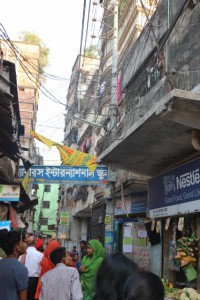Project Overview
■ Background
Bangladesh is one of the countries that is most affected by natural disasters. Risks of disasters such as earthquakes in urban areas have also been rising. Bangladesh is located near the tectonic plate and in addition, there are five active faults within the country (active faults are geological faults that are likely to become the source for earthquakes sometime in the future). According to earthquake experts, earthquakes occur in 100 years interval in this region, and predict that the next big one could occur anytime.
One of the reasons for the huge extent of damage due to earthquakes that have been pointed out is vulnerability of buildings. In April 2013, the collapse of Rana Plaza in the suburb area of Dhaka city became the worst accident in the garment industry as a result of illegal construction.
Moreover, without preparedness, panic during evacuations may also become a serious issue. Theses vulnerable conditions to earthquake and current construction system are not likely to change in a short span of time. There is a strong need for capacity building in communities, and enhance coordination capacities among DRR stakeholders to assist communities to cope with disaster risks.
Damage risks due to storms or floods are also high in Dhaka North city. By using management tools such as Climate Disaster Resilience Indicators (CDRI), an investigation on the response capacity of the old Dhaka city (now the Dhaka North and South city) to meteorological disasters was conducted in 2009. The result pointed out that floods occurred every year in riverside areas. In addition, the number of fires has been increasing every year. Dhaka saw a total of was 17,192 cases in 2013.
Much needs to be done to help communities in the target area cope with the above mentioned disaster risks, including self-help and mutual-help abilities, as well as building residents’ disaster response capacities.


■Purpose
To build up a system in which the communities in Dhaka North city can implement DRR activities in a continuous manner.
■Expected Outcomes and Indicators
Output 1:Training human resources for the promotion of community DRR
Activities:
1.1 To implement disaster risk management in cooperation with the city, wards and universities.
1.2 To cooperate with government and academia to implement investigation meetings and workshops aiming at implementing community DRR-related items mentioned in the Contingency Plan into practice.
1.3 To create a feasible action plan for community DRR promotion based on the result of the workshops mentioned in 1.2.
1.4 To implement community DRR concerned training for the city officials.
Output 2:Building three models of DRR community
Activities:
2.1 To select model communities that will take a pioneering role in practicing action plan for community DRR promotion from the communities that want to implement DRR activities. Implement DRR training for leaders of model communities.
2.2 To establish a committee in each model community to implement DRR activities.
2.3 To support in making local DRR activity proposal that includes task allocation, drill plan, model community’s contacts/ network for emergency cases.
2.4 To monitor DRR activities based on the local activity proposals of model communities.

Output 3:Establishment of a system in which the model of practicing DRR community can be widely expanded and disseminated.
Activities:
3.1 To create program and educational materials (DRR community operation guideline) for training of DRR community promoting leaders based on the practice of model community.
3.2 To implement workshop on support of the city for community’s DRR activities, and create the city’s DRR community register system.
3.3 To hold an Information Session about DRR community register system, and recruit communities that want to implement activities in DRR.
3.4 To implement DRR training for the residents of registered communities and support in creating local DRR activity proposal (After submitting activity proposal, the community can register to the city as a DRR community)
3.5 To monitor DRR activities of DRR communities.
Output 4:Meaning of community DRR are widely shared and understood
Activities:
4.1 To build a platform to disseminate DRR information on websites or social media.
4.2 To implement training on the management of the platform.
4.3 To have DRR-related information or introduction of DRR activities (output 2) shared on the platform by the members of fire station.
4.4 To convey the meaning and necessity of DRR community widely to general citizens through media campaign or Information Session.
